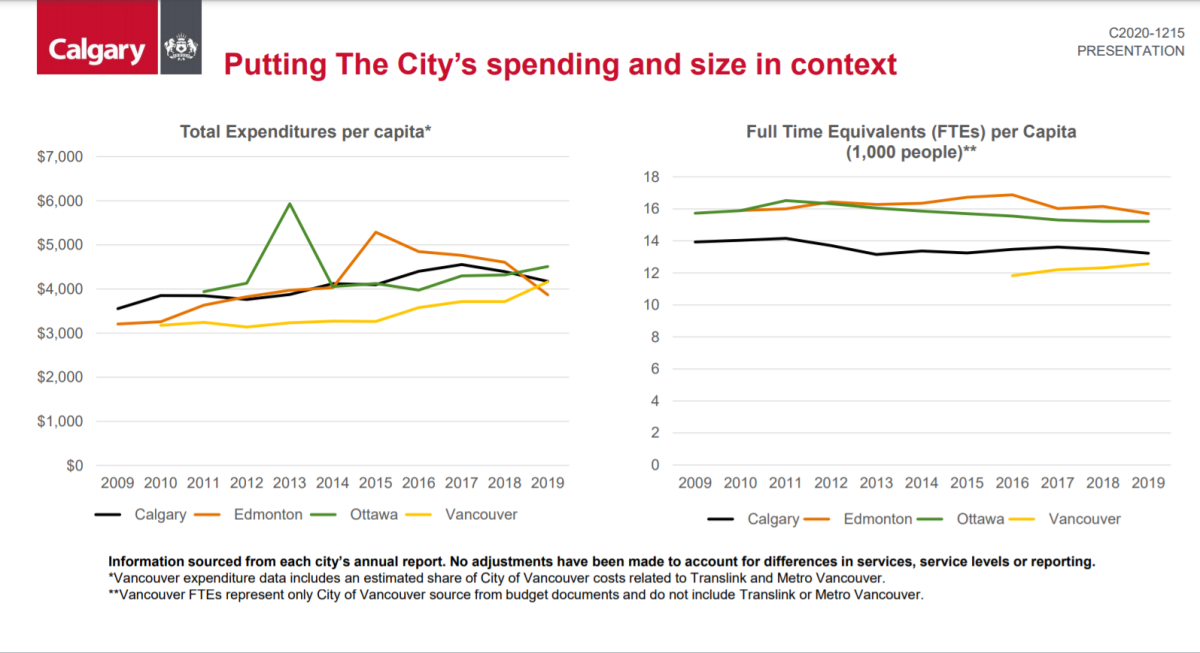Calgarians will see a slight decrease on their municipal taxes as a whole, if approved by city council.

City administration announced Monday overall the city could see a 1.66 per cent tax rate decrease in 2021, with a 0.67 per cent decrease for residential properties and a 0.55 per cent dip for non-residential properties on average.
Council’s direction to administration in July was a zero increase.
Assessments to single family homes in the city could have resulted in a 0.58 per cent increase in municipal taxes. Instead, administration is recommending those homeowners get a one-time rebate resulting in a zero per cent increase for those types of homes.
But the change in property taxes for individual homeowners depends on changes in valuation and how those changes compare to other homes.
Because high-rise apartments and large-format warehouses saw increases in assessed value, those types of properties will see an increase in their taxes. Hotels and downtown “AA class” office space will see a decrease in their tax bills, largely because of their decreased valuations.

Some large format warehouses could see as much as a nearly 25 per cent increase in their municipal taxes after an average 14.25 per cent increase in their value, depending on whether the properties are affected by the phased-tax program. Hotels could see a 27.7 per cent decrease in their city taxes after those properties shed an average of 31.2 per cent of their value. And according to examples from city administration, businesses along 17 Avenue S.W. could see property tax increases in the double-digits.
Ward 1 Coun. Ward Sutherland said the wild differences in how businesses are taxed show the state of the tax assessment system.
“This is a broken system that we do not write; the province does,” Sutherland said. “We need this fixed because every single year we run into this and it’s not fair to other businesses. And it’s not fair to Calgarians when it comes to housing.
“So, again, we’re going to have to look at potentially one-time money, which is burnt through, never used again, and is not a smart strategy to deal with this issue.”
“As much as I hate saying it, I think that we are going to have to look at some sort of a rebate for those businesses in this year because you don’t want to just pile on with what a difficult year they’ve had,” Calgary Mayor Naheed Nenshi said. “But at some point, we actually have to let the market work.”
Reduction of full-time equivalent jobs
One of the recommendations to council is a net reduction of 162 full-time equivalent (FTE) jobs through measures like not filling vacant positions, not hiring new positions and some layoffs. That would reduce the city’s workforce by about one per cent, and the mix of those categories is to be decided by city council. Since 2019, 574 FTEs have been reduced in the city’s workforce.
“Council still needs to debate and approve what we’ve put forward with them,” Calgary’s chief financial officer Carla Male said. “Traditionally, there have been vacancies or positions not yet filled that would assist in some of the balancing. But we just don’t know at this stage what that balance of the vacant positions versus positions with individuals in them.”
Since 2019, 574 FTEs have been reduced in the city’s workforce and the city currently employs the same number of people as it did in 2013.

Get daily National news
“Since 2013, we’ve added 200,000 people to Calgary — we’ve added two Red Deers,” Nenshi said. “And we are still having the same number of civil servants as we had then. And in fact, there’s going to be fewer civil servants going forward.”
The reductions in FTEs is part of the $90.7 million in savings city officials are proposing for 2021.
Base reductions counted for $63 million, including $24 million from “service owners” like the Calgary Police Service.
Following Friday’s budget submission released by the Calgary Police Commission, city administration said they are willing to “work collaboratively with the Calgary Police Service to explore funding models that will see $8 million dedicated from the Police budget to explore community based services in 2021.”

Ward 11 Coun. Jeromy Farkas called administration’s recommendations “a start,” but wants to see further cuts.
“I think we’re going to at least need about another $90 million to be able to get us to where we need to go. And there is room within the budget for that,” Farkas said Monday. “I strongly believe that we can accommodate at least a five per cent reduction in non-essential services without Calgarians feeling the impact of that.”
But the mayor believes citizens will feel cuts to civic services, saying concerns about roads and parks maintenance are already coming to light.
“If members of council want to go further, I’ll say what I say every year — tell us where.”
“And to find that in one month — I mean, don’t be ridiculous. Either you want cuts or you want to preserve services, you can’t have both.”
SAVE program
Administration found $26 million in savings to date through the Solutions for Achieving Value and Excellence (SAVE) program, started in Nov. 2019. That exceeded council’s goal of finding $24 million in savings.

The program received ideas from city employees and administration, and brought in consultants from in-house and accounting firm EY. More than 2500 ideas were brought forward and 40 specific opportunities were identified that the city could make happen. City council has final say on which opportunities will be acted on.
City officials aren’t proposing any budget adjustments in 2021 as a result of the coronavirus pandemic, but said they will be “managing the financial impacts on an ongoing basis consistent with the approach in 2020.”

Administration said the pandemic caused a finances gap of $55 million in 2020 and projects the gap in 2021 to be $52 million.
Sutherland also pointed to more than $200 million in federal pandemic support money in helping the city prevent further cuts to front-line services.
“If we did not have that money, we wouldn’t be talking the way we’re talking right now,” the Ward 1 councillor said. “We couldn’t do any reductions. In fact, there would be significant problems.”
The mayor acknowledged the city is still forecasting “quite a large deficit” to close 2020.
“However, we believe that the Municipal Operating Support Transfer Program, which is the federal government’s restart money, some of which has been matched by the province, should look after this year’s deficit with a little bit to spare,” Nenshi said. “It has to be spent by March 31st, but that little bit to spare will help us in two ways — number one is it will help us deal with the first quarter of next year, the first three months, and number two, we do have enough that we can help in emergency situations with our civic partners or nonprofit organizations who are in extremely bad shape.”
Transit revenue woes continue
Nenshi said that one common theme he’s hearing from other mayors across Canada is how dire the situation is with transit.
“I think the big city mayors are meeting with the deputy prime minister and minister of finance as soon as tomorrow,” the mayor said. “It is very clear that, particularly for cities that rely on transit, even in the best case scenario for a vaccine, we’re going to see at least a half a year of really reduced revenues from transit.”
Currently, half of Calgary Transit’s budget comes from fares and half from the city’s operating budget.
Doug Morgan, the city’s acting transportation GM, said Calgary Transit has seen ridership return to between 80-85 per cent of pre-pandemic levels since school has returned, a “sweet spot we see with demand.”

“That means the intensity of use is less and our revenues will be less,” Morgan said, noting transit revenue will be in the red at the end of 2021. “So we’re trying to do the best we can to balance the health event along with revenues and the amount of service on the street.”









Comments